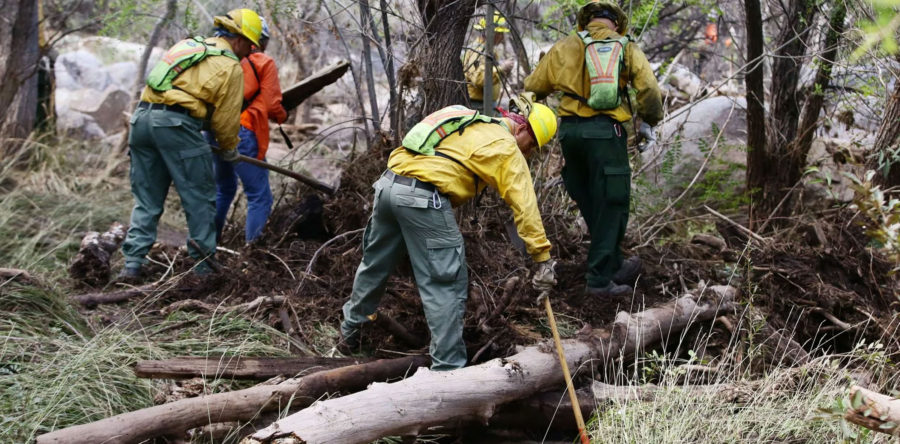On Saturday July 15th, 2017, a flash flood decimated a popular swimming hole near Payson, AZ, killing 10 people - all from one extended family. The family had made the trek to the Cold Springs swimming hole to celebrate a birthday. And in an instant, they were gone. No warning, no chance and no hope to survive the 6ft tall wall of water moving at 45 mph.
"They had no warning. They heard a roar and it was on top of them" said Water Wheel Fire and Medical District Fire Chief Ron Sattelmaier to azcentral.com.
The flash flood was the result of the perfect combination of events and circumstances. A powerful wildfire - the Highline Fire - had burned a large area upstream of Cold Springs earlier in the summer. With no trees or foliage to block the rain water, soot and debris washed downstream causing a "40-foot-wide black wave" to wash away the family. It is possible that it could have been worse - upwards of 100 people were in the area of the creek at the time of the flash flood.
"They had no warning. They heard a roar and it was on top of them"
According to those who were there, it wasn't even raining at Cold Springs. The storm was almost 8 miles upstream, near the burn area.
According to Arizona Emergency Information Network, more than 40 people have died in Arizona flash floods since 1996. In 1970 more than 20 people died in a single Labor Day weekend flash flood- again in and around Payson - as Tropical Storm Norma dumped 11 + inches of rain in 24 hours. Unfortunately, the list doesn't end there.
Flash Flood - What's the Cause?
Obviously, a flash flood happens when an extreme amount of rain falls in a relatively short amount of time. But, there can be compounding factors that make the situation deadly.
In Arizona, especially in the spring and early summer, we may go 3 months or more without significant rainfall. In that time, the dry ground in the washes, stream and river beds hardens to the point where it can't efficiently absorb water. So when something like an Arizona summer monsoon hits, it can be a recipe for disaster.
It's not uncommon for a monsoon storm to dump an inch of rain or more in less than a hour. All that water has to flow someplace and it WILL find it's way into those dry beds. With nothing to absorb the water, what might be a small trickle can grow to be a raging wall of destruction - sometimes in 5 minutes or less. That wall will take anything in it's path including boulders, trees, cars, and unfortunately people. People who may not even realize they are camping or hiking in a danger zone.
Avoid the Situation - Don't be a Victim
So how can you tell if you are entering a potential flash flood danger area?
- Do your research ahead of time. Find out if the area you plan on exploring has a history of flash floods or poor weather.
- Check the weather - and not just where you're heading. Check the surrounding areas too, see if those areas upstream are expecting bad things.
- Look for flood evidence once you arrive. Are you camping in a low lying area compared to your surroundings? Is there debris where it normally wouldn't be - like logs wedged in between boulders, debris high up in the trees, or water lines high on canyon walls?
-Ask locals if there are places to avoid etc. They will know better than anyone.
- Have an escape plan - if possible. If given enough warning, where will you and your group go to escape? Remember to think "upwards" as well. Is there a spot to scramble up canyon walls or higher ground ? Try to go twice as high as you think you need to be. If escape isn't possible, is it worth going?
Do your due diligence and hike smart
Can Technology Help Prevent Tragedy?
We've all been sitting in a restaurant or meeting when simultaneously everyone's phone gives off the shrill, loud warning tone of a weather alert. It's jarring, it grabs your attention and you inevitably look at your phone.
So if that technology exists, can it be implemented into GPS units for backcountry use?(I did look to see if this was a feature on some GPS Units already, and the results were unclear) Cell phone signal is not always guaranteed on the trail, and in fact most of us leave the cell behind or off to enjoy the solitude of the backcountry experience. But perhaps sending weather related alerts via GPS is a way to minimize the risk of being caught totally off-guard.
Should state, local or federal agencies implement early warning systems in areas such Cold Springs? It certainly seems that technology like that could be put to great use. You can't cover 100% of the backcountry, but maybe alarms at high density attractions would be worth the investment.
But ultimately, the burden falls on you. Entering into nature is never 100% safe. By planning ahead and being aware of potential hazards, you can stay safe in the backcountry.
Photo courtesy: Rob Schumacher/The AZ Republic






